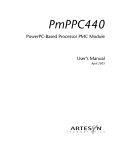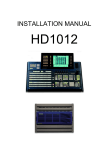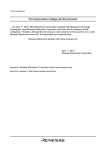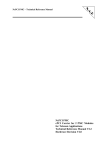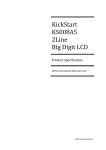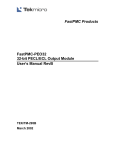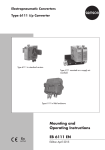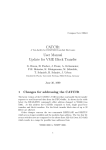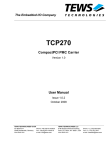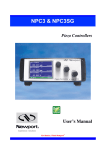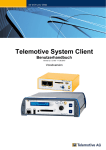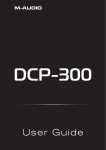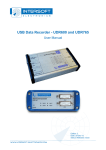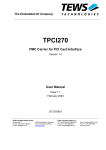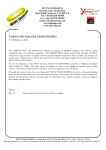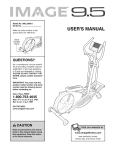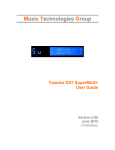Download CATCH-X Users Manual
Transcript
COMPASS-Note 2000-12 CATCH-X Users Manual H. Fischer, J. Franz, A. Grunemaier, F.H. Heinsius, L. Hennig, K. Konigsmann, M. Niebuhr, T. Schmidt, H. Schmitt, J. Urban Fakultat fur Physik, Universitat Freiburg, 79104 Freiburg, Germany July 19, 2000 The CATCH-X module is a 6U one-mezzanine version of the 9U four-mezzanine CATCH module. The CATCH module is used in the COMPASS experiment as the driver of the front-end boards and serves as a data concentrator and mini-event builder before the data are transmitted to the readout buer. The CATCH-X module facilitates the testing of the readout of the front-end electronics. It can be used either with the COMPASS trigger control system or independently of it, e.g. for test beam activities. 1 Contents 1 Introduction and Overview 1.1 1.2 1.3 1.4 COMPASS readout CATCH-X . . . . . Contents . . . . . . Literature . . . . . . . . . . . . . . . . . 2 Installation 2.1 2.2 2.3 2.4 CATCH Mezzanine Card TCS Receiver . . . . . . S-Link LSC . . . . . . . Jumper and Switches . . 3 Software 3.1 3.2 3.3 3.4 3.5 VME Access . . . . . User Interface . . . . FPGA-Programming F1 initialisation . . . Data Format . . . . . . . . . . . . . . . . . . . . . . . . . . . . . . . . . . . . . . . . . . . . . . . . . . . . . . . . . . . . . . . . . . . . . . . . . . . . . . . . . . . . . . . . . . . . . . . . . . . . . . . . . . . . . . . . . . . . . . . . . . . . . . . . . . . . . . . . . . . . . . . . . . . . . . . . . . . . . . . . . . . . . . . . . . . . . . . . . . . . . . . . . . . . . . . . . . . . . . . . . . . . . . . . . . . . . . . . . . . . . . . . . . . . . . . . . . . . . . . . . . . . . . . . . . . . . . . . . . . . . . . . . . . . . . . . . . . . . . . . . . . . . . . . . . . . . . . . . . . . . . . . . . . . . . . . . . . . . . . . . . . . . . . . . . . . . . . . . . . . . . . . . . . . . . . . . . . . . . . . . . . . . . . . . . . . . . . . . . . . . . . . . . . . . . . . . . . . . . . . . . . . . . . . . . . . 3 3 4 5 5 6 6 6 7 7 9 . 9 . 9 . 9 . 15 . 15 4 Hardware 16 5 Appendix 23 4.1 Front Panel and LEDs . . . . . . . . . . . . . . . . . . . . . . . . . . . . . . . . 16 4.2 Pin-Out Tables . . . . . . . . . . . . . . . . . . . . . . . . . . . . . . . . . . . . 18 4.3 Power and Fuses . . . . . . . . . . . . . . . . . . . . . . . . . . . . . . . . . . . 21 5.1 CMC-HOTlink . . . . . . . 5.1.1 Connector and LEDs 5.1.2 Data Format . . . . 5.2 TDC-CMC . . . . . . . . . 5.2.1 Connector and LEDs 5.2.2 Data Format . . . . . . . . . . . . . . . . . . . . . . . . . . . . . . . . . . . . . . . . References . . . . . . . . . . . . . . . . . . . . . . . . . . . . . . . . . . . . . . . . . . . . . . . . . . . . . . . . . . . . . . . . . . . . . . . . . . . . . . . . . . . . . . . . . . . . . . . . . . . . . . . . . . . . . . . . . . . . . . . . . . . . . . . . . . . . . . . . . . 23 23 23 24 24 25 25 2 1 Introduction and Overview 1.1 COMPASS readout ) (Fibre The CATCH-X (CATCH = COMPASS Accumulate, Transfer and Control Hardware), a multipurpose frontend-electronic driver and readout module, has been developed in the scope of the COMPASS experiment located at CERN. This state-of-the-art xed target spectrometer is capable of standing beam intensities of up to 2 108 particles/spill. At a maximum trigger rate of 105 events/s several Gigabyte of data has to be read every second with negligible dead time. The readout architecture of the LAT Calorimeter RICH SAT COMPASS experiment is summaAPV 6 ASD8b QVC GASSIPLEX rized in Figure 1. Data are digiF1 TDC DSP tized right at the detector by the front-end electronics wherever pos1 16 FE-boards sible. In case of analog readout the (detector mounted) ... pedestal subtraction and zero supmax. 40 MB/s/link pression is performed by the front(CAT 5+) (~ 20 m) end at the detector. To suppress (Trigger, Clock, event id) TCS background for time measurements (Fibre) CATCH only those hits are transfered to the (9U VME) (Setup data) VMEbus data recording units which have a (~ 150 m) correlation to a trigger time. S-Link The data are transmitted from max. 100 MB/s/link the front-end to the CATCH modules through twisted pair cables or optical bres. The FPGA based ... ... ... ... ROB VME module serves as an interface between the front-end of the detector systems and an optical S-LINK, GigaBit which transmits the data to the 100 MB/s/link Central Readout Buer (ROB). It also acts (Fibre) Data GigaBit Switch as an fan-out for the COMPASS trigRecording ger distribution and time synchroni(~ 5 km) sation system (TCS). The readoutdriver monitors the trigger and data Filter Filter Filter Filter ow to and from the front-ends. In addition a specic data buer structure and sophisticated data ow con- Figure 1: The architecture of the COMPASS detector trol is used to pursue local pre-event readout. building. At startup the module controls all necessary front-end initialisations. From the CATCH data are transmitted via a standardized link to the read-out buers (ROB) which can store all data from at least one spill. The backbone of this data transfer is the S-link 1] interface and the S-LINK data transfer protocol. Presently about 128 S-LINK C P U 3 G i g a B i t R O B C P U G i g a B i t R O B C P U G i g a B i t R O B C P U G i g a B i t R O B connections are foreseen to transmit data with a maximum total bandwidth of about 12 GB/s. The read-out buers combine data which belong to one event, check consistency of the data and perform sub-event-building. In a next step they transmit the sub-events via Gigabit Ethernet to lter computers. Here the nal event-building is performed and events are reconstructed. The lter farm will reduce the data based on physics cuts by a factor of 5 to 10 and a continuous rate of 12 to 30 MB/s will be transfered to the central data recording facilities at CERN. 1.2 CATCH-X CATCH-X 6U VME board (16 cm x 23.3 cm) ROB S-LINK (LSC) Output FIFO Mezzanine Merge & Filter Formatting Control TCS-Receiver via P2 connector Sort/Merge FE-Board FE-Board Trigger & Clock distr. HOTLink Mezzanine 4 HOTLink Receiver Trigger & Clock distr. FE-board setup VME Interface Figure 2: CATCH-X schematic with HOTLink mezzanine card. The CATCH-X is designed similar to the CATCH but as a 6U VME-module. This reduces the maximum number of inputs by a factor of four compared to the 9U sized CATCH. Figure 2 shows a block diagram of the CATCH-X overall architecture with the HOTLink mezzanine card. The CATCH-X module with HOTLink mezzanine card performs the setup, trigger and clock distribution to the front-end boards and the data transfer from the FE-boards 4 via CAT 5+ (Ethernet) cable. The data from 4 connected front-end-boards are received at a rate of up to 40 MByte/s per link. Alternative mezzanine cards are available for data transmission through optical bres, for time-to-digital conversion on the CATCH and deadtime free scalers. Trigger timing is received from a trigger control-system mezzanine card. For standalone operation a Dummy TCS-card with NIM-input and local clock is available. The trigger, time synchronization, reset and one user signal are distributed to the front-end-boards. The event number is added to the event header. Programmable logic chips perform event sorting, header suppression, adding of geographic identications and mini-event building. Formatted events are sent to the readout-buers using S-link with a rate of about 100 MByte/s. All or prescaled events can be sent through the VME-bus at a speed of 10 MByte/s. 1.3 Contents This document describes the CATCH-X for the general user and can be used mainly as a reference guide. Chapter 2 shows the required steps before installing the module in a VME crate. An introduction to the software to control the module via the VMEbus and a list of registers can be found in chapter 3. Also the current version of the output data format can be found here. The chapter 4 lists the pin assignments for all connectors, the front-panel, fuses, switches, and jumpers. As a quick reference the HOTLink Mezzanine card and the TDC mezzanine card is documented in the Appendix. 1.4 Literature For further reading the following literature is recommended: An introduction to the COMPASS readout scheme: TDC Chip and Readout Driver Developments for COMPASS and LHC-Experiments 2]. The description of the F1 TDC: An Eight Channel Time-to-Digital Converter Chip for High Rate Experiments 3] and A 8 channel time to digital and latch integrated circuit for the COMPASS experiment at CERN 4]. The front-end board connection to the CATCH/CATCH-X through the HOTLink: Designing Front-End Boards for use with the CATCH-HOTLink Interface, COMPASS note 1999-7 5]. The specications of the CATCH (9U version): em CATCH and CMC-HOTLink Readout Driver Specication 6]. The COMPASS Online Data Format (COMPASS-Note 2000-8) 7]. The newest software and documentation can be found on the web page: http://hpfr02.physik.uni-freiburg.de/compass 5 2 Installation Before the installation of the CATCH-X 6U VME-board one has to mount the following cards: The input is provided through the CATCH Mezzanine Cards. Currently one has the option between a CMC-HOTLink card to connect front-end boards via twisted pair cables and a TDC-CMC which provides up to 32 TDC channels. The output data stream can either ow through the S-Link LSC card mounted on top or through the VME bus, in which case the S-Link card is not required. The trigger and synchronisation signals are either received through the standard COMPASS trigger control system (TCS) and the TCS-Receiver or through NIM pulses converted in the TCS-Dummy receiver. 2.1 CATCH Mezzanine Card CATCH mezzanine cards have the size of standardized common mezzanine cards 8] and are mounted on the lower part of the CATCH-X to which it connects through two mezzanine connectors. Several types are currently foreseen: HOTLink-CMC with RJ-45 connector for cable interface. HOTLink-CMC with bre interface (development in cooperation with Trieste group). TDC-CMC with four F1 chips. Fast dead-time free scaler on FPGA. Some features of the HOTLink-CMC and the TDC-CMC are summarised in the Appendix 5.1 and 5.2, respectively. Details on the CATCH mezzanine card specication can be found in 9]. 2.2 TCS Receiver The trigger control system interface (TCS) can be plugged into the P2 connector on the back. The TCS-receiver transient card gets the trigger and timing information from the Compass trigger distribution system via optical bre. This board has outputs for the main clock (38.88 MHz), trigger, reset, begin of burst, end of burst, data enable and error bits as well as data bits. Alternatively a TCS-dummy receiver can be plugged into the P2 backplane connector. This board has NIM inputs (including trigger, begin/end of burst, reset) and one local 38.88 MHz clock to provide TCS functionality in standalone operations. It is pin compatible to the Compass TCS-receiver card (Table 13). 6 2.3 S-Link LSC The CATCH-X board is designed such that a standard duplex S-LINK Link Source Card (LSC) can be plugged in at the upper part of the CATCH-X and connects through one mezzanine plug to the main board. Details can be found in the S-LINK interface specications 1]. The pin out can be found in that documentation in table 21 (page 49). The size of these cards are based on single size Common Mezzanine Cards as dened in Ref. 8]. The S-Link card provides a bre connection to the spill buer PCI-cards, which reside in the readout buer PCs (ROB). The S-Link card is optional, alternatively the data can be read out via VME bus at a lower speed. 2.4 Jumper and Switches The jumpers have to be set according to table 1 to the default positions, except for the TDCCMC, which requires jumper 3 in position 2-3. The base address of the board can be selected by two rotary switches SW1 and SW2. For specics refer to section 3. 7 Table 1: CATCH-X jumper positions. The default positions are for the CMC-HOTLink and the TDC-CMC, except jumper 3, which has to be set to position 2-3 for the TDC-CMC. For the locations of the jumpers see gure 4 Jumper default alternate description JP 1 2-3,4-5 (no VME-Interrupt) JP 2 open (no VME-Interrupt) JP28 2-3 Sync Trigger 1-2 async Trigger for RICH JP 3 1-2 CMC-TCLK: 40 MHz local osc. 2-3 CMC-TCLK: 38.88 MHz from TCS For on board clock distribution (debugging only): JP16 1-2 JP 8 open JP 4 open JP 5 open JP 6 open JP 7 open JP 9 open JP10 open JP12 open JP11 open JP18 open JP13 open JP14 open JP15 open JP17 open JP19 open JP20 open JP22 open JP21 open 8 3 Software A compilation of the software mentioned here can be found in the compass project space at /afs/cern.ch/compass/online/util/catch/. Executables are available in bin, bin/AIX, bin/Linux for MVME PowerPCs and Intel-VMIC, respectively. 3.1 VME Access The CATCH-X can be accessed through a standard VME interface using the A32/D32 address mode. The base address is in hexadecimal notation: E0 ab 00 00 where the byte ab can be selected by the two address selectors on the board. Switch 1 and 2 are corresponding to the value a and b, respectively. In the following tables (2-10) all registers are described together with their oset to the base address and whether read or write access is possible. Do not try to access any other addresses as this may hang your software. Note that some registers are only available after programming the FPGAs (Tab. 3-9). The spy buer can be read out using normal transfers or block transfers. In case the spy buer is empty a 0x00 00 00 00 is returned. It is recommended to check the ags and/or the number of values in the spy-buer before reading a block of data. 3.2 User Interface For the convenience of the user two types of interfaces are provided. A full screen interface written in tcl/tk named CatchX-o-Matic provides access to all registers through a several windows. Details can be found in ref. 10]. Through a command line interface each register can be read or written to: vme read address vme write address value where address and value is given as a hexadecimal value. Do not forget the base address 0xE0 00 00 00 of the CATCH. For example the command vme read E00A0000 reads the identication and serial number of the CATCH-X whose the address switch is set to 10. While the command vme write E0010800 100 resets the CMC-card mounted on the CATCH-X with the address set to 1. 3.3 FPGA-Programming The functionality of the CATCH-X board is provided through the use of six eld programmable gate arrays (FPGA). Because the programming is stored in RAM, they have to be reprogrammed after every power up. The programming is done by executing the command 9 Oset 00 00 00 04 00 10 00 20 00 40 00 80 01 00 02 00 Table 2: VME registers always available (in CPLD). Read/Write Bits Description R 0-15 CATCH-X serial number 16-31 'CA01' CATCH-X identication R 27 TRIGGER (unused) CATCH-X status 26 FPGA pin TDO (JTAG) 25 CMC pin TDO (JTAG) 24 FPGA programming busy 23 FPGA INIT (programming pin) 22 FPGA DONE (programming pin) 21,20 Spy buer FIFO 1/2 empty 19 Spy buer FIFO almost empty) 4 words) 18 Spy buer FIFO half full (2048 words) 17 Spy buer FIFO almost full (4092 words) 16 Spy buer FIFO full 15- 00 Number if words in Spy FIFO (+2) W 0 1 = Enable FPGA programming pins (PROG) 1 1 = Disable FPGA programming pins (PROG) 2 1 = set FPGA PROG pin (low) 3 1 = reset FPGA PROG pin (high) 4 1 = enable FPGA JTAG pins (TCK,TDI,TMS) 5 1 = disable FPGA JTAG pins (TCK,TDI,TMS) 6 1 = enable CMC JTAG pins (TCK,TDI,TMS) 7 1 = disable CMC JTAG pins (TCK,TDI,TMS) W 0-31 Send 32 bits of programming data to FPGA via DIN/CCLK W 0 TCK = 1 JTAG interface to FPGAs W 1 TCK = 0 W 2 DIN = 1 W 3 DIN = 0 W 4 TMS = 1 W 5 TMS = 0 W 0 TCK = 1 JTAG interface to CMC W 1 TCK = 0 W 2 DIN = 1 W 3 DIN = 0 W 4 TMS = 1 W 5 TMS = 0 W 0 1 = enable FPGA programming (DIN, CCLK) 1 1 = disable FPGA programming (DIN, CCLK) 4 CCLK = 1 5 CCLK = 0 6 DIN = 1 7 DIN = 0 W Reset FPGAs 10 Table 3: SERIAL-FPGA VME registers (available after FPGA programming). Oset Read/Write Bits Description 04 00 W 11..0 Serial setup bits 23..12 for 1st FE-board (store bits) 04 10 W 11..0 Serial setup bits 11..0 for 1st FE-board (send all 24 bits) 04 04 W 11..0 Serial setup bits 23..12 for 2nd FE-board (store bits) 04 14 W 11..0 Serial setup bits 11..0 for 2nd FE-board (send all 24 bits) 04 08 W 11..0 Serial setup bits 23..12 for 3rd FE-board (store bits) 04 18 W 11..0 Serial setup bits 11..0 for 3rd FE-board (send all 24 bits) 04 0C W 11..0 Serial setup bits 23..12 for 4th FE-board (store bits) 04 1C W 11..0 Serial setup bits 11..0 for 4th FE-board (send all 24 bits) Table 4: CONTROL-FPGA VME registers (available after FPGA programming). Oset Read/Write Bits Description 08 00 R 0-7 CONTROL FPGA design version number 8 BUSMODE of CMC card 9 IS24 (CMC-HOTLINK receiving 24 bit data) 10 BUSY 0 (serial interface 0 busy) 11 BUSY 1 (serial interface 1 busy) 12 BUSY 2 (serial interface 2 busy) 13 BUSY 3 (serial interface 3 busy) 08 00 W 0-3 LED 1-4 "OFF" on 4-7 LED 1-4 "IDs" on 8 reset CMC-card 9 reset SLINK-FPGA 10 reset TCS-FPGA 11 reset FORMAT-FPGA 12 reset MERGE-FPGA 13 reset SERIAL-FPGA Table 5: FORMAT-FPGA VME registers (available after FPGA programming). Oset Read/Write Bits Description 10 00 R 0-7 Formatter FPGA design version number 8-15 Data format identication 10 04 R/W 0-9 source id (as given in the S-link header 10 08 10 0C 10 10 R/W R/W R/W 10 14 R/W 0-15 0-15 0-7 8-15 0-7 Following numbers need to be set for begin of run event: CMC id CATCH S/N TCS design version SLINK design version MERGE design version 11 Table 6: TCS-FPGA VME registers (available after FPGA programming). Part I Oset Read/Write Bits Description 14 00 W 0 0: USR3=End of Burst, 1: USR3 = Pretrigger 1 1: TCS dummy connected select ONLY when TCS clock a 14 04 W 0 1 send USR4 25 ns (front end reset) 1 1 send USR4 400 ns (front end reset for CMC) 14 00 R Status Register: 0-7 TCS FPGA design version number 8 Pretrigger as USR3 9 encoded USR signal output enable 10 TCS Ready 11 TCS Error 12 Currently Burst 13 RESET 14 04 R 0-15 trigger counter in current spill 14 08 R 0-15 trigger counter in last spill 14 0C R 0-7 TCS receiver id 8-15 TCS status register after last error 14 10 R 14 14 14 18 R R 14 1C R 0-4 5-15 0-15 0-3 8-15 0 1 2 3 4 5 6 7 8 9 10 11 12 13 7 numbers below are from current event: trigger mask spill number event number bit 0-15 event number bit 16-19 error word skip current event mode of current event Status FIFO empty Status FIFO full Data FIFO empty Data FIFO full FILLED = TCS data ready for current event EREADY (Merge ready) FREADY (Format ready) HDEF (Header buer empty ag) MEVTRDY (Event number ready ag) THREADY (TCS Header ready) MEVTSEL (Merger) HDREN (Formatter) 12 Table 7: TCS-FPGA VME registers (available after FPGA programming). Part II Oset Read/Write Bits Description 14 20 R 0-3 addr 0 from tcs fo 4-7 addr 1 from tcs fo 8-11 addr 2 from tcs fo 12-15 addr 3 from tcs fo 14 24 R 0-3 addr 4 from tcs fo 4-7 addr 5 from tcs fo 8-11 tcs data fo counter 12-15 status fo counter 14 28 R 0-15 TCS header in counter in last spill 14 2C R 0-15 TCS header out counter in last spill Table 8: SLINK-FPGA VME registers (available after FPGA programming). Oset Read/Write Bits Description 18 00 W 0-1 0: Spymode write 1 event if FIFO empty 1: Spymode write events until FIFO full 2: Spymode write every 4 event until FIFO full 3: Spymode write every 8 event until FIFO full 2 send URESET 3 send 3 testwords 4 send UTEST (32x SLINK test pattern) 5 Reset spy FIFO 18 00 R 0-7 SLINK FPGA design version number 18 04 R 3 HeaderEF 4 DataEF 5 SpyEF 6 LFF (link full ag) 7 LDOWN (link down) 13 Table 9: MERGE-FPGA VME registers (available after FPGA programming). Oset Read/Write Bits Description 20 00 R 0-7 MERGE FGPA design version number 20 10 W 0-3 '0' for FIFO on '1' for FIFO o 20 10 R 0-3 Status: FIFO on (1) or o (0) 4-7 Status: FIFO empty (1) or not (0) 8 '1' Is TDC-CMC 9 '1' Is HOTLink-CMC 10 '1' Is HOTFibre-CMC 11 '1' Is Scaler-CMC 12 '0' = TDC locked, '1' = TDC not locked 13 (debug) FIFO 0 last 14 (debug) FIFO 1 last 15 (debug) FIFO 2 last 20 20 R 15-0 16 bit id of the CMC-card 20 30 R 15-0 16 bit of number of received events 20 30 W 5-0 denition of trailer for TDC readout (24 bit) Table 10: Spy buer readout. Oset Read/Write Bits Description 80 00 R 0-31 Read data from spy buer (block transfer possible) 8F FF 14 catch-x-n.nn.hex boardid on the command line of the VME computer. The le catch-x-n.nn.hex is provided with the user interface software. The boardid is the CATCH-X board id in hex, as selected by the two rotary switches. It can take values between 0 and FF. In case the PROG LED lits red an error has occurred. Check, that you have used the correct le and not interrupted the programming. progcatch 3.4 F1 initialisation A F1 frontend board or TDC-CMC connected to the CATCH-X can be initialised by the command: f1setup tdc.f1 boardid -port where tdc.f1 is the le as generated by f1conf, boardid is the CATCH-X board id in hex, -port is the input port number. 3.5 Data Format The format of the output data is given in Tab. 11. The data in the Data Block depends on the connected front-end electronics and the version of the format programmed in the FPGAs. For details see 7]. Table 11: Format of data send through the S-Link or spy buer. The event size counts all words (32 bit) excluding the two CTRL words (rst and last word). 31 SLINK-Header 0000000 (28) error ev. type (5) source ID (10) status spill nr. (11) format version (8) 0 0=CTRL (4) event size, excl. CTRL words (16) event nr. ( 20) Format Identier #err words (8) TCS error (8) status (8) Data Block Data, format dened by format version SLINK-Trailer CFED120 (28) 15 0=CTRL(4) 4 Hardware 4.1 Front Panel and LEDs Figure 3: CATCH-X front panel and module. On the front panel are several LEDs, as described in table 12, a cutout for the S-LINK LSC CMC, a reset button and a cutout for the CATCH Mezzanine Card. Reset switch. 16 Name PWR VME PRG ID color green yellow red green Table 12: LEDs on front panel. Description 5 V Power available Board is currently accessed through VME If lit the FPGA's are not correctly programmed '-' if FPGAs are not programmed. Otherwise shows the selected board address (lower 4 bits). TCS red Red, if the synchronisation clock is generated internally. O, if the clock is received through the TCS system. TRG green On if triggers are received from the TCS system. 24 yellow On if CATCH-Mezzanine card produces 24 bit data (e.g. from TDC) O, if 32 bit data is received (e.g. through HOTLink from RICH). OFF red On, if port 1,2,3 or 4 is disabled. IDs red On, if setup data is received on port 1-4 of the HOTlink-CMC. FF red On, if the FIFO on port 1-4 is full. 17 4.2 Pin-Out Tables On the mother board are connectors for initial programming and debugging of the programmable logic chips as well as the connectors to the mezzanine cards: JTAG port for Xilinx CPLD programming (9 pins CPLD JTAG). Program connectors for Xilinx FPGAs (X-Checker and JTAG) cable (18 pins FPGA PROG, FPGA JTAG). A JTAG port to the CATCH mezzanine card (9 pin CMC JTAG). An ISP-Port to program the Lattice-ispGAL (4 pins SCLK/GAL, MODE, SDO, SDI). Two 64 pin connectors for the CATCH mezzanine card (see table 14 and 9]). One 64 pin connector for the S-Link card. (In the 9U CATCH module the J3 connector is used.) Additionally standard VME backplane connectors are used to implement A32/D32 data transfers. No VME interrupts are generated. The TCS card is connected via the VME-J2 backplane connector. Signal names are listed in table 13. Table 13: P2 connector pin assignment for TCS receiver. Note that signal C12 (Receiver Ready) can be switched from active low to active high by setting bit 1 in register 0x14 00. Pin Active I/O Symbol Symbol I/O Active Pin A1 + I +PECL clock GND C1 A2 I -PECL clock GND C2 A3 GND GND C3 A4 H I Data 0 Data1 I H C4 A5 H I Data 2 Data3 I H C5 A6 H I Data 4 Data5 I H C6 A7 H I Data 6 Data7 I H C7 A8 H I/O Address 0 Address 1 I/O H C8 A9 H I/O Address 2 Address 3 I/O H C9 A10 L I Header ready Header enable O L C10 A11 H I TTL clock Status enable O L C11 A12 L I Data mode Receiver ready I L* C12 A13 H I (Synch) Start of burst End of burst I H C13 A14 H I SynchTrigger PreTrigger I H C14 A15 L I (Synch)Reset Error I L C15 A16 L I Skip data AsynchTrigger I H C16 18 Table 14: Pin denitions of the CATCH mezzanine card 9]. Pin Symbol D31..0] DX3..0] Pin Name Data outputs Data extension I/O Description O O Data outputs. Additional bits used for error information. RCLK# Read clock I The rising edge clocks data D, DX out of the module when REN3..0]# is LOW. REN3..0]# Read enable I REN# enables the RCLK input. OE3..0]# Output enable I When OE# is LOW D,DX drive the bus, (=REN3..0]#) when HIGH D,DX are in high impedance state. EF3..0]# Empty ag O When LOW no data available, synchronized to RCLK. PAE3..0]# Programmable O When LOW almost no data available, empty ag synchronized to RCLK, the minimum amount of available data has to be specied. FF3..0]# Full ag O When LOW internal buers are full, not synchronized to RCLK. RST# Reset I Asynchronous reset. BUSMODE1 Busmode 1 O Busmode, identies card type. BUSMODE4..2] Busmode I Busmode, questions card type. DEVID Device id I If HIGH puts device identication on D15..0]. DEVST Device status O If LOW signal error condition of card. SND3..0] Serial input I Four independent 10 Mbaud serial links. synchronous to TCLK. TCLK time clock I Time distribution 38.88 MHz TTL clock. DTCLK di clock I Dierential low jitter TCLK signal. USR3..0] User signals I Trigger, time zero and user signals synchronous to TCLK. USRC User coded I Length coded USR3..0] signals, synchronous to TCLK. TDI Test data input I JTAG TDI TMS Test mode select I JTAG TMS TDO Test data output O JTAG TDO TCK Test data clock I JTAG TCK TRST# Test data reset I/O Test reset 19 Table 15: Connector pin-outs of the CATCH mezzanine card 9]. Pn1/Jn1 Pn2/Jn2 Pin Signal Name Signal Name Pin Pin Signal Name Signal Name Pin 1 3 5 7 9 11 13 15 17 19 21 23 25 27 29 31 33 35 37 39 41 43 45 47 49 51 53 55 57 59 61 63 TCK Ground EF1]# BUSMODE1# DEVID Ground RCLK Ground DX2] +5V D28] D25] Ground D22] D19] +5V EF0]# Ground EF2]# Ground PAE0]# DX0] +5V D12] D9] Ground D6] D4] +5V D2] D0] Ground -12V FF1]# PAE1]# +5V USR0] USR1] Ground DX3] +5V D31] D27] Ground REN3]# D21] +5V D17] Ground FF3]# +5V FF0]# DX1] Ground D15] D11] +5V REN0]# D5] Ground D3] D1] +5V USRC 2 4 6 8 10 12 14 16 18 20 22 24 26 28 30 32 34 36 38 40 42 44 46 48 50 52 54 56 58 60 62 64 1 3 5 7 9 11 13 15 17 19 21 23 25 27 29 31 33 35 37 39 41 43 45 47 49 51 53 55 57 59 61 63 20 +12V TMS TDI Ground USR2] BUSMODE2# RST# 3.3V USR3] D30] Ground D24] EF3]# 3.3V D18] D16] Ground PAE2]# Ground PAE3]# 3.3V REN1]# D14] Ground D8] D7] 3.3V SND2] TCLK Ground DTCLK+ Ground TRST# TDO Ground LVDS low LVDS high +3.3V BUSMODE3# BUSMODE4# Ground D29] D26] +3.3V D23] D20] Ground REN2]# +3.3V FF2]# Ground DEVST Ground D13] D10] +3.3V SND0] SND1] Ground SND3] +3.3V DTCLK- 2 4 6 8 10 12 14 16 18 20 22 24 26 28 30 32 34 36 38 40 42 44 46 48 50 52 54 56 58 60 62 64 4.3 Power and Fuses The board uses 5V, +12V and -12V from the VME P1 and P2 connector. The voltages +12V and -12V are only provided for the CMC board and not used by the motherboard. A DC/DC converter produces 3.3V from the 5V supply. The types of the dierent fuses are given in table 16, while its positions on the CATCH-X is shown in gure 4. Table 16: Fuses Name Value Voltage Used for F1 250 mA 5 V FPGA-JTAG / CMC-JTAG F2 250 mA 5 V FGPA-PROG / CPLD-JTAG F3 5A 5 V VCC F4 0.5 A +12 V CMC F5 0.5 A -12 V CMC F6 0.5 A 5 V VCC-PECL F7 5 A 3.3 V Power supply 21 F2 SW2 SW1 S-LINK LSC F3 F5 F4 F7 CATCH Mezzanine Card F1 F6 Figure 4: Positions of fuses, jumpers and switches on CATCH-X. 22 5 Appendix 5.1 CMC-HOTlink The CMC-HOTLink cards serve as a general interface to the front-end boards: Each CMC cards connects up to four front-end boards Receive data through HOTLink deserialiser chips at a maximum rate of 40 MByte/s on each of the four channels Convert data from 8 bit HOTLink transmission format to 24 or 32 bits (1 word) depending on front-end board Word boundaries are automatically resynchronized at each received SYNC character The most signicant byte is received rst (bits 31-24) Receive errors are marked by special error codes Store data in four independent 1k 4byte FIFOs for nal event building Maximum CMC output rate 160 MByte/s 5.1.1 Connector and LEDs Each CMC-HOTLink has four RJ-45 connectors for CAT5+ cable (Table 17) to the front-end board. The ports are number from top to bottom 1 to 4. Details on the connection can be found in Ref. 5]. The four red LEDs correspond to port 1 to 4 counted from left to right. They are lit in case of errors are transmitted through the cable. During normal operation the LEDs are o. Table 17: RJ-45 front-end board connector. Pin Description 1 38.88 MHz clock, PECL 2 38.88 MHz clock, PECL + 3 10 Mbaud serial line, active low signal 6 10 Mbaud serial line, +5 V power supply for opto coupler 5 Trigger/User (coded 25-100 ns), LVDS 4 Trigger/User (coded 25-100 ns), LVDS + 7 400 MHz HOTLink, PECL 8 400 MHz HOTLink, PECL + 5.1.2 Data Format The data format is dened according to Ref. 5]. 23 5.2 TDC-CMC The TDC-CMC contains four F1 TDC chips numbered from 0 to 3. Channels 0-7 are connected to TDC '0', whereas channels 24-31 are connected to TDC '3'. The details of the TDC operation can be found in Ref. 4]. 5.2.1 Connector and LEDs A 68 pin connector from Robinson-Nugent has been chosen as the input interface to the four F1 TDCs on the TDC-CMC. Two 34-wire twisted pair cables (AWG-28, 0.05") t to a single socket. A special latching eject mechanism facilitates mating and unmating. The socket, which goes on the cable is available from Robinson Nugent1 part number P50E068S-TGF or CERN self service number 09.55.21.071.4. The four red LEDs show the following signals (from left to right): FIFO full, Token, PLL locked, TDC Be-INIT. Upon power on reset all four LEDs are on. Table 18: TDC-CMC 68-pin Robinson Nugent input connector. If the F1 TDC-CMC board is used in the high resolution mode only the pins marked by '*' are active. All other inputs will be ignored. Pin Signal Pin Signal A01 In 0 + * B01 In 16 + * A02 In 0 * B02 In 16 - * A03 In 1 + B03 In 17 + A04 In 1 B04 In 17 A05 In 2 + * B05 In 18 + * A06 In 2 * B06 In 18 - * A07 In 3 + B07 In 19 + A08 In 3 B08 In 19 . . . . . . . . . . . . A31 In 14 + * B31 In 31 + * A31 In 14 - * B31 In 31 + * A31 In 15 + B31 In 32 + A32 In 15 B32 In 32 A33 GND B33 GND A34 GND B34 GND Input level is either: LVDS, LVPECL or dierential TTL (second line: +2.5V xed). On board input termination: '+' 3.6k to 5V, '-' 1k to GND, between '-' and '+' 100. 1 Robinson Nugent (Europe) B.V.,P.O. Box 70062,NL-5201 DZ 's-Hertogenbosch, The Netherlands. http://www.robinsonnugent.com. 24 5.2.2 Data Format The 24-bit output data of the TDC chips as described in the F1 TDC manual 4] are mapped to bits 8-31. Bit 0-3 indicates whether the TDC 0,1,2 or 3 is locked (active high). Bits 4-7 are always zero. Table 19: Incoming TDC data format. Shown is the format of the header and data. For each event one header is followed by n data words and one trailer, which has the same format and event number as the header. The event data may be intercepted by more headers, e.g. in case of the trigger buer overow error is set. l0 - l3 corresponds to the TDC locked signals of TDC 0 to 3. 31 30 29 24 23 15 14 13 12 9 8 7-4 3 2 1 0 0 trigger buer Event Trigger XOR chip/channel 0 l3 l2 l1 l0 overow (1) number (6) time (9) address (6) (4) 1 0 chip/channel data (time measured relative 0 l3 l2 l1 l0 address (6) to last reference signal) (16) (4) References 1] Bowle et al., The S-LINK Interface Specication, http://www.cern.ch/HSI/s-link/, ECP Dvision, CERN, 1997. 2] G. Braun et al., TDC Chip and Readout Driver Developments for COMPASS and LHCExperiments, Fourth Workshop on Electronics for LHC-Experiments, Rome, September 21-25 1998 CERN/LHCC/98-36. 3] G. Braun et al., An Eight Channel Time-to-Digital Converter Chip for High Rate Experiments. Fifth Workshop on Electronics for LHC-Experiments, Snowmass, September 20-24, 1999. 4] Braun et al., A 8 channel time to digital and latch integrated circuit for the COMPASS experiment at CERN, Universitat Freiburg, 1999. 5] Braun et al., Designing Front-End Boards for use with the CATCH-HOTLink Interface, COMPASS note 1999-7, Universitat Freiburg, 1999. 6] G. Braun et al., CATCH and CMC-HOTLink Readout Driver Specication , COMPASS note 1999-15, Universitat Freiburg, 1999. 7] H. Fischer et al., The COMPASS Online Data Format, COMPASS note 2000-8, Universitat Freiburg, TU Munchen, 2000. 8] IEEE P1386/Draft 2.0 04-APR-1995, Standard for a Common Mezzanine Card Family: CMC (the CMC Standard). 25 9] Braun et al., Draft Standard for CATCH Mezzanine Cards: CATCH/OPEN , Universitat Freiburg, 1999. 10] Braun et al., CatchX-o-Matic User Manual, HTML: http://hpfr02.physik.uni-freiburg.de/~hennigla/manual/ 26



























